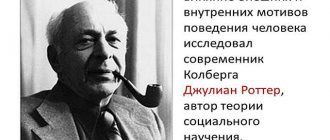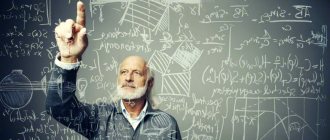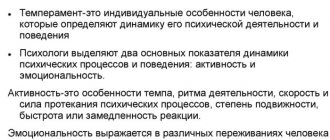The study of the human psyche has intrigued society for hundreds of years. However, most people still cannot find an answer to many questions about their personality. Detailed psychoanalysis can shed light on some of them. How does it work, what is its history? What makes us make the same mistakes? How can childhood events influence our present? You will find the answers in the article.
What is psychoanalysis: the essence of the theory
Let's define the concept. The name is derived from two Greek words: “soul” and “decomposition, dismemberment.” The concept entered the scientific community in 1896 after the publication of a German article on the origin of neuroses. It is no longer possible to say exactly who first introduced the concept of psychoanalysis, but Sigmund Freud is considered its founder. It was he who invented psychoanalysis and proposed it as a branch of psychology.
The Laplanche and Pontalis dictionary gives the following definition of psychoanalysis: “This is a research method based on identifying the unconscious meanings of words, actions, products of human imagination (dreams, fantasies, delusions); a method for treating neurotic disorders based on this research; a set of theories of psychology and psychopathology that systematizes data obtained by the psychoanalytic method of research and treatment.”
Thus, psychoanalysis in simple words is a scientific theory and method of treating mental disorders. It is currently being considered in three areas:
- as a psychological and philosophical theory of personality;
- as a set of principles and methods for studying the unconscious of the individual;
- as a direction in psychotherapy that helps get rid of intrapersonal conflicts, neuroses, complexes, psychoses, depression, phobias and other problems.
Psychoanalysis in psychology is considered both theory and practice. Let's look at the essence of S. Freud's theory of psychoanalysis.
What does psychoanalysis study? Unconscious motives and desires of the individual. If we talk about psychoanalysis as a theory, then its essence can be reflected in several theses (features):
- the conflict between the conscious and unconscious leads to the development of neuroses, fears, depression and other psychological problems;
- thoughts and behavior are determined by unconscious desires;
- awareness of true motives, needs, desires is difficult due to the inclusion of protective mechanisms of the psyche;
- psychological problems can be solved if they are brought to the level of consciousness (this can be done using psychoanalytic methods).
The basic idea of Freud's psychoanalysis is that there can be no inconsistency or interruption in human mental nature. That is, everything that a person has in the present is the result of the past. If something doesn’t suit you now, then you need to look for the reason in the past. And now we will analyze everything in more detail and in order.
Resistance processing process
An important stage is overcoming resistance and psychoanalysis of the individual. It begins with the doctor revealing to the patient those thoughts, feelings and resistances that have never been recognized before. After which the mentee is given time to penetrate as deeply as possible into resistance unknown to him until now, in order to further process and overcome it.
What are the patient's resistances? First of all, this is a mechanism that works on an unconscious level, and its task is to prevent the awareness of those unacceptable thoughts and desires that were previously repressed. Freud wrote that processing resistance is a very difficult part, and in practice it becomes truly painful not only for the patient. The psychoanalyst also faces a real test of patience. However, despite the complexity, it is this part of the work on consciousness that has the maximum transformative effect on the patient. This is where analytical treatment differs from treatment by suggestion.
Who is the founder of psychoanalysis
The author of the theory and founder of the method of psychoanalysis is the Austrian psychologist, psychoanalyst, psychiatrist and neurologist Sigmund Freud. He was also the founder of the school of psychoanalysis. Sometimes the theoretical basis of psychoanalysis (Freud's philosophy) is called Freudianism. Freud's theory had a significant influence on psychology, medicine, sociology, anthropology, literature and art of the 20th century.
Interesting! Freud's closest followers were K. Jung, K. Horney, A. Adler, E. Fromm and others. Some of the modern psychologists also rely on Freud's teachings.
Basics of psychoanalysis
The unconscious, sexual instinct, sublimation, Freudian slip - you may have heard these concepts. All of them relate to psychoanalysis. Do you know their definitions and essence? Now let’s figure it all out, consider the basics of personality psychoanalysis, and analyze the key concepts.
Consciousness and unconsciousness
In the theory of psychoanalysis, Freud identified 2 structures of the psyche. Each of them has three layers, but these structures are somewhat different from each other. First, let's look at the layers of the first structure:
- Unconscious. All secret desires, repressed memories, animal instincts, immoral desires are stored here.
- Preconscious, or subconscious. At this level is located what a person knows and remembers at the present time or, if desired, can remember.
- Consciousness. These are thoughts, feelings, emotions, plans of a person in the present.
This is the primary structure of the psyche according to Freud. Later, the psychoanalyst discovered the method of free associations and developed a new structure (concept) of the structure of the psyche. In it he identified three elements: It, I and Super-ego.
"It", "I" and "Super-ego"
According to the theory of psychoanalysis, our psyche has three levels:
- Id (It), or lower level. This is the level of instincts, drives - everything that remains in us from animals. This is also the level at which all repressed desires, memories, and needs are stored. Simply put, this is the level of the unconscious (popularly it is often called the subconscious, but now you know the difference). What happens at this level is beyond our control. It reminds itself of itself through emotions and feelings, mental states, dreams, slips of the tongue and typos, bodily symptoms, etc.
- Ego (I), or middle level. This is the field of our awareness. Experience, knowledge, skills, beliefs and everything that we have accumulated in the process of socialization have gathered here. We control and understand everything that is here, we can control our thoughts and behavior.
- Super-Ego (Super-I), or highest level. This is our inner moralist, critic and censor - conscience, if you like. At this level all our ideas about “what is good and what is bad” and how we should behave in society are located.
Often the id and the superego come into conflict, and the ego tries to reconcile them. In fact, every person spends most of his life in such a search for a balance between animal instincts and the highest moral values, prohibitions, and norms. Not everyone manages to maintain balance; sometimes we are tossed in one direction (we give in to desires, emotions), then in the other (we rationalize life too much, block our feelings and suppress desires). Both are dangerous. If falling to one side occurs too often, a person develops complexes, neuroses and other psychological problems.
Important! Suppressed desires lead to the development of complexes. Sublimation helps get rid of frustration (experience due to the inability to satisfy a need).
Defense Mechanisms
According to Freud, any psychological problems are associated with the conflict between the animal and the social in man. That is, when a person suppresses desires that are shameful by social standards, he gets sick, becomes aggressive, apathetic, and irritable. This can be avoided if you redirect the animal impulse into a productive direction: creativity, sports, career building, social activity. This is called sublimation - the transfer of sexual energy to another activity. Sublimation is one of the protective mechanisms of the psyche named by Freud.
Methods of psychoanalysis
As we have already found out, psychoanalysis is not only a theory, but also a practice. With its help, you can diagnose and correct your mental state. Psychoanalysis includes many techniques for working with the unconscious, but all of them can be divided into three groups.
Methods of psychoanalysis:
- Interpretation. The point is to analyze and comprehend minor elements: slips of the tongue, random phrases, errors in speech, etc. The psychoanalyst and the client talk about the person’s past, present and visible future, and during this the specialist identifies hidden problems and fears. That is, he interprets the client’s words and helps to “translate” them. Interpretation does not act as an independent method, but as an auxiliary one. For example, it is used in combination with two other popular methods of psychoanalysis: the method of free association and the method of dream interpretation.
- Free associations. The psychoanalyst calls the client words, phrases or shows pictures and invites him to respond with the first thing that comes to mind. Auxiliary materials are prepared in advance. They can be developed by the psychologist himself for a specific case. Or the specialist uses well-known techniques, for example, the Rorschach drawing test (ink spots on paper). It was Freud, with his psychoanalysis and the method of free association, who created the image of a patient lying on a couch and a psychologist listening to the client. In life, such communication is rare, but then Freud interacted with clients this way. He invited the person to lie down on the couch, relax and start saying whatever came to mind. Strange, obscene, fantastic, shameful - it doesn’t matter. There are no taboos in the psychoanalyst’s office, and the specialist adheres to the principle of a non-judgmental attitude. Sooner or later, in the process of such a free flight of associations, a person independently came to the main conflict.
- Analysis of dreams. Nowhere does the unconscious manifest itself more actively than in dreams. Particular attention should be paid to recurring dreams or dreams after which a person wakes up “broken.” According to Freud, the stranger the dream, the more meaning it makes. The fact is that in dreams any prohibitions and censorship disappear, defense mechanisms are turned off, everything that has accumulated there comes out of the unconscious. However, not all so simple. True experiences, desires, needs in dreams are shown by symbols. And these are the symbols that the consciousness of a particular person will accept. That is, a certain “filter” is preserved even in the realm of the unconscious – sleep. To immerse yourself in the art of reading dreams, study S. Freud's book “The Interpretation of Dreams.”
Using these methods, you can look into a person’s unconscious, identify repressed desires, emotions and memories, understand the motives of actions and correct behavior.
Important! Do not confuse psychoanalysis with psychotherapy. The psychoanalyst is largely responsible for ensuring that the person speaks freely and finds the origins of the problems themselves, as well as their solution. The psychoanalyst guides, but does not give direct instructions and advice.
Dream interpretation
One of Freud's most popular theories was the interpretation of dreams. The psychoanalyst described dreams as messages from the unconscious part of the brain, which are encrypted and represent meaningful images. When Freud was seventy years old, in 1931 the book “The Interpretation of Dreams” was republished for the third time. The professor himself wrote that this work contains the most valuable of all the discoveries he made in his entire life. Freud believed that such insights occur only once in a person’s entire life.
Concept
We have already said a lot about Freud’s theory, but all of this is somehow generalized, mixed up (new and old). What is the concept of Freud's original theory of psychoanalysis? Let us outline the main provisions (features) of psychoanalysis:
- All psychological problems of the individual are caused by the conflict between the conscious and unconscious.
- Physiological needs suppress the needs of higher levels. As Freud said, “at the basis of all our actions are the desire to become great and the sexual desire.”
- Every incident in a person's life has its consequences.
- Every action has an obvious or hidden motive, which is associated with a person’s previous experience.
- The individual development of a subject is determined by the structure of the personality, childhood and youth experience.
- The psyche is a complex mechanism consisting of three levels: It, I, Super-ego. It is important to study all this in a comprehensive manner and look for the causes of psychological problems in the present at the level of the It (unconscious).
Conclusion
Despite his reputation among some fellow scientists as a sexually preoccupied neurotic, Freud was not a pseudoscientist, and his theory is not false. Controversial - yes, largely speculative, but confirmed by numerous examples, cases from real life, the experience of psychiatrists, psychologists, psychotherapists.
And in times of sexual revolutions constantly shaking the world, the frantic pace of life and associated stress, Freud’s theory has become mega popular, having answers to all questions.
What directions (types) of psychoanalysis exist today?
In modern theories of psychoanalysis, the emphasis has shifted from sexuality. Psychologists consider not only this need as the cause of all troubles, but also other unmet needs.
For example, people with a heightened and unsatisfied need for power often become tyrants at home or at work. People who lack warm social contact surround themselves with animals. People who cannot or are afraid to have children, but want it, also direct their energy towards animals, for example, cats. Women who cannot succeed as professionals find themselves in raising children.
Classical Freudian psychoanalysis is one of the types of this teaching known to psychology. There are other schools (directions) of psychoanalysis. Let's briefly highlight them:
- Ego psychology. If Freud paid more attention to the Id, then here all attention is focused on the Ego (I), that is, the conscious part of the personality.
- Object Relations Theory. This theory is based on the proposition that the psyche is a system of internal objects that are a reflection of people and situations from the outside world. The specifics of relationships with people in the present and the life scenario are determined by the childhood experience of the subject. That is, in adulthood a person reproduces what he was used to in childhood.
- M. Klein School. The psychoanalyst paid more attention to child psychoanalysis, in particular to the analysis of the Oedipus complex. She considered love and aggression as the main driving forces of the psyche. The first one heals, the second one splits the psyche.
- Structural psychoanalysis by J. Lacan. The psychoanalyst viewed a person strictly as a subject and proposed solving psychological problems through speech. He considered the basis of personality to be a tandem of three elements: imaginary (a person’s idea of himself based on knowledge of other people), symbolic (search for differences in himself and others), real (situation, place where the individual first met another). The psychoanalyst depicted this as a symbol of three connected rings. If even one ring is opened, the mental balance of the individual will be disrupted.
- Interpersonal psychoanalysis (G.S. Sullivan, Clara Thompson). Attention is focused not on the analysis of personality, but on the analysis of interpersonal relationships. It was this element that psychoanalysts considered the most important and significant in the mental development of the subject.
There are other modern areas of psychoanalysis, but these are the most in demand.
Life instinct and death instinct
Instincts are the driving, motivational forces of the individual, biological factors that release reserves of mental energy. For Freud, instincts are not innate reflexes, but that part of the stimulation that comes from the body. The purpose of instincts is to eliminate or reduce stimulation through certain types of behavior (for example, eating or sexual activity).
Z. Freud identified 2 large groups of instincts: life and death.
Life instincts (Eros) include hunger, thirst, sexual activity and are aimed at the self-preservation of the individual and the survival of the species. These are creative, life-sustaining forces. The form of psychic energy in which they manifest themselves is called libido. Libido is a certain amount of mental energy that finds release exclusively in sexual behavior.
Freud believed that humans also have a desire for death. Death instincts (Thanatos) are destructive forces that can be directed both inward (masochism or suicide) and outward (hatred and aggression). Unlike the energy of libido, as the energy of the life instincts, the energy of the death instincts has not received a special name. However, Freud considered them biologically determined and as important in the regulation of human behavior as the life instincts. Towards the end of his life, Freud increasingly became convinced that the instinct of aggression could be very powerful as a motivating factor.
How psychoanalysis influenced the development of psychology
Freud's theory of psychoanalysis contributed to the development of psychology. Psychoanalysis made a real revolution in the world of psychotherapy and psychiatry. This theory was reflected in the works of other psychologists (representatives of psychoanalysis): A. Freud, D. Winnicott, H. Hartmann, M. Mahler, E. Glover, E. Erikson, M. Klein and others. Direct followers of Freud are Carl Jung, Alfred Adler, Otto Rank, H. Hartman, E. Chris, Anna Freud (daughter of the famous psychoanalyst).
What is the significance of psychoanalysis for fundamental and practical psychology? After Freud's discoveries, researchers began to pay more attention to the topic of defense mechanisms of the psyche, stages of mental development of the individual, levels of consciousness, and psychosomatic disorders. Dreams received special attention. Before the publication of the book “The Interpretation of Dreams” by S. Freud, they were not given such importance.
Interesting! Freud's teachings even influenced cinema. Alfred Hitchcock, Federico Fellini, Michelangelo Antonioni, Paolo Pasolini were inspired by his works.
Criticism
Freud's theory immediately attracted public attention. But it cannot be said that it was exclusively positive - there were many critics. And until now, Freud's teachings are subject to critical analysis. Here's what he's criticized for:
- too much emphasis on human sexuality;
- a strange attitude towards childhood sexuality (some researchers find the idea of the Oedipus complex wild);
- there is a possibility that the client’s condition will worsen during psychoanalysis (based on a 1994 study that proved that behavioral therapy is more effective than psychoanalysis);
- it is difficult to test the theory experimentally, since too much attention is paid to the human unconscious;
- there is too much subjectiveness in theory and psychoanalysis as an applied method of psychotherapy;
- Freud’s painful desire to look for mental pathology in everything (there are cases when Freud mistook the somatic problems of patients for mental disorders, for example, he diagnosed a patient with toothache as “Hysterical neurosis”).
Some psychologists still consider Sigmund Freud's psychoanalysis a pseudoscience. They doubt its validity, reliability and effectiveness.
Interesting! Freud's theory causes admiration or indignation, but it does not leave anyone indifferent.
Another neo
In addition to Erich Fromm, Harry Sullivan, an outstanding American psychiatrist and founder of transpersonal psychoanalysis, became a prominent representative of neo-Freudianism. He, like Fromm, made an attempt to combine several areas at once: psychiatry, psychoanalysis, psychology, sociology, philosophy and cultural studies. But if Fromm ultimately reduced everything to the dichotomy of “loving or being loved,” then Sullivan, who became interested in researching schizophrenic disorders, came to the conclusion that in order to understand the nature of psychopathology and help a person, it is not enough to study only his personality.
Sullivan believed that the formation of a mental disorder is influenced by a huge number of sociocultural factors. And the very development of an individual occurs in the process of a person’s interaction with people who are emotionally significant to him. It was this idea that formed the basis of the theory of interpersonal relationships.
The main task for Harry Sullivan was to bring psychiatry and social sciences closer together, because he thought of the development of the human self only in terms of the interaction of this self with society and its assimilation of social assessments and roles. Sullivan took a lot of his theory from Freud; in addition, among his inspirations he named George Herbert Mead, John Dewey, Charles Cooley, as well as Ruth Benedict and Edward Shapiro.
According to Sullivan's views, man is a complex biosocial system. He represented the development of the individual as a process of continuous exchange of information between the individual and the surrounding world. Just after being born, each of us feels the need for contact with other people, and this need is biological. The absence of such contact not only disrupts the development process, but also leads to psychopathological disorders.
The situations of interaction with the world that we find ourselves in throughout our lives, from the moment of birth to death, are repetitive. And everyone learns a certain algorithm of actions - reactions to a certain situation.
Another important factor for human development is anxiety. Sullivan distinguishes two types of it: a) biologically determined “normal” fear when perceiving a real threat and b) acquired anxiety, not associated with real dangers, which causes disorganizing tension. Without the first, existence is impossible; such fear is the key to survival. The second is a powerful block in the development of an individual’s creative potential and the cause of severe violations in interaction with society.
Sullivan paid great attention to the issue of protective mechanisms, in particular dreams, myths and mythologems, both common to all humanity and personal myths, which, according to his views, are personal protection for each of us.
Sullivan was far ahead of his time; his ideas underlie group and family therapy, which began to develop only at the end of the twentieth century.
Alternatives
Alternatives to psychoanalysis include cognitive behavioral psychotherapy, art therapy, Jungian analytical psychotherapy, behaviorism, Gestalt therapy, logotherapy, positive psychotherapy, psychodrama, body-oriented psychotherapy, Ericksonian hypnosis. All this, like psychoanalysis, methods of psychotherapy. They cannot fully replace each other, because these are completely different directions, but they have the same goal - to help a person realize the internal problem and get rid of it.











